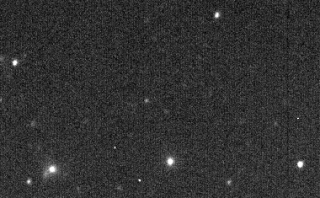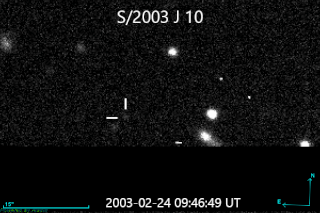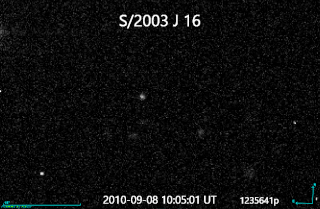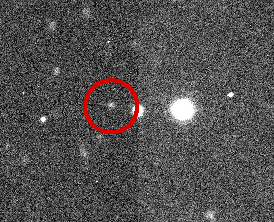Related Research Articles

Erriapus, or Saturn XXVIII (28), is a prograde irregular satellite of Saturn. It was discovered by Brett Gladman, John J. Kavelaars and colleagues in 2000, and given the temporary designation S/2000 S 10. It was named Erriapo in August 2003 after Erriapus, a giant in Gaulish mythology; the name was changed from dative Erriapo to nominative Erriapus per IAU conventions in late 2007.

S/2003 J 2 is a retrograde irregular satellite of Jupiter. The moon was discovered on 5 February 2003 by a team of astronomers from the University of Hawaii led by Scott S. Sheppard and David C. Jewitt, and was later announced on 4 March 2003. It was initially thought to be Jupiter's outermost known moon until recovery observations disproved this in 2020.
Eirene, also Jupiter LVII and originally known as S/2003 J 5, is a retrograde irregular satellite of Jupiter. It was discovered by a team of astronomers from the University of Hawaii led by Scott S. Sheppard in 2003 but was then lost. It was recovered in 2017 and given its permanent designation that year.

S/2003 J 9 is a retrograde irregular satellite of Jupiter. It was discovered by a team of astronomers from the University of Hawaii led by Scott S. Sheppard in 2003.

S/2003 J 10 is a retrograde irregular satellite of Jupiter. It was discovered by a team of astronomers from the University of Hawaii led by Scott S. Sheppard et al. in 2003.

S/2003 J 12 is a natural satellite of Jupiter, and is one of the smallest known natural satellites in the Solar System. It was discovered by a team of astronomers from the University of Hawaii led by Scott S. Sheppard in 2003.

S/2003 J 16 is a natural satellite of Jupiter. It was discovered by a team of astronomers led by Brett J. Gladman in 2003.

Jupiter LV, provisionally known as S/2003 J 18, is a natural satellite of Jupiter. It was discovered by a team of astronomers led by Brett J. Gladman in 2003.

S/2003 J 23 is a natural satellite of Jupiter. It was discovered by a team of astronomers from the University of Hawaii led by Scott S. Sheppard et al. in 2004 from pictures taken in 2003.
Fenrir, or Saturn XLI, is a natural satellite of Saturn. Its discovery was announced by Scott S. Sheppard, David C. Jewitt, Jan Kleyna, and Brian G. Marsden on May 4, 2005, from observations taken between December 13, 2004, and March 5, 2005. Fenrir has an apparent magnitude of 25, making it one of the faintest known moons in the Solar System, and was discovered using some of the largest telescopes in the world. It is even too dark to have been observed by the Cassini spacecraft when it was in orbit around Saturn, for which it never got brighter than approximately 17th apparent magnitude. Fenrir was named after Fenrisulfr, a giant wolf from Norse mythology, father of Hati and Skoll, son of Loki, destined to break its bonds for Ragnarök.

Hati or Saturn XLIII is a natural satellite of Saturn. Its discovery was announced by Scott S. Sheppard, David C. Jewitt, Jan Kleyna, and Brian G. Marsden on 4 May 2005, from observations taken between 12 December 2004 and 11 March 2005.
S/2004 S 7 is a natural satellite of Saturn. Its discovery was announced by Scott S. Sheppard, David C. Jewitt, Jan Kleyna, and Brian G. Marsden on 4 May 2005 from observations taken between 12 December 2004 and 8 March 2005.

Bestla or Saturn XXXIX is a retrograde irregular moon of Saturn. Its discovery was announced by Scott S. Sheppard, David C. Jewitt, Jan Kleyna, and Brian G. Marsden on 4 May 2005, from observations taken between 13 December 2004 and 5 March 2005.
S/2004 S 17 is a natural satellite of Saturn. Its discovery was announced by Scott S. Sheppard, David C. Jewitt, Jan Kleyna, and Brian G. Marsden on 4 May 2005 from observations taken between 13 December 2004 and 5 March 2005.
S/2004 S 13 is a natural satellite of Saturn. Its discovery was announced by Scott S. Sheppard, David C. Jewitt, Jan Kleyna, and Brian G. Marsden on 4 May 2005 from observations taken between 12 December 2004 and 9 March 2005.
S/2006 S 1 is a natural satellite of Saturn. Its discovery was announced by Scott S. Sheppard, David C. Jewitt, Jan Kleyna, and Brian G. Marsden on June 26, 2006 from observations taken between January 4 and April 30, 2006. S/2006 S 1 is about 6 kilometres in diameter, and orbits Saturn at an average distance of 18.65 Gm in 951.1 days, at an inclination of 154.6° to the ecliptic, in a retrograde direction and with an eccentricity of 0.0814.
S/2006 S 3 is a natural satellite of Saturn. Its discovery was announced by Scott S. Sheppard, David C. Jewitt, Jan Kleyna, and Brian G. Marsden on June 26, 2006 from observations taken between January and April 2006.
S/2007 S 2 is a natural satellite of Saturn. Its discovery was announced by Scott S. Sheppard, David C. Jewitt, Jan Kleyna, and Brian G. Marsden on May 1, 2007, from observations taken between January 18 and April 19, 2007. S/2007 S 2 is about 5 kilometres in diameter, and orbits Saturn at an average distance of 16,054,500 kilometres in 759.2 days, at an inclination of 176.65° to the ecliptic, in a retrograde direction and with an eccentricity of 0.237. According to Denk et al. (2018), it is presumably at high risk of colliding with Phoebe in the future.
S/2007 S 3 is a natural satellite of Saturn. Its discovery was announced by Scott S. Sheppard, David C. Jewitt, Jan Kleyna, and Brian G. Marsden on 1 May 2007 from observations taken between 18 January and 19 April 2007.
Saturn LX, provisionally known as S/2004 S 29, is a natural satellite of Saturn and a member of the Gallic group. Its discovery was announced by Scott S. Sheppard, David C. Jewitt, and Jan Kleyna on October 7, 2019 from observations taken between December 12, 2004 and January 17, 2007. It was given its permanent designation in August 2021.
References
- ↑ Discovery Circumstances from JPL
- 1 2 3 4 "MPEC 2022-T128 : S/2004 S 12". Minor Planet Electronic Circular. Minor Planet Center. 12 October 2022. Retrieved 12 October 2022.
- 1 2 3 S.S. Sheppard (2019), Moons of Saturn, Carnegie Science, on line
- ↑ Jacobson, R.A. (2007) SAT272 (2007-06-28). "Planetary Satellite Mean Orbital Parameters". JPL/NASA. Archived from the original on 2011-08-10. Retrieved 2008-01-20.
{{cite web}}: CS1 maint: numeric names: authors list (link) - ↑ Jacobson, B.; Brozović, M.; Gladman, B.; Alexandersen, M.; Nicholson, P. D.; Veillet, C. (28 September 2012). "Irregular Satellites of the Outer Planets: Orbital Uncertainties and Astrometric Recoveries in 2009–2011". The Astronomical Journal. 144 (5): 132. Bibcode:2012AJ....144..132J. doi: 10.1088/0004-6256/144/5/132 . S2CID 123117568.
- ↑ Ashton, Edward; Gladman, Brett; Beaudoin, Matthew (August 2021). "Evidence for a Recent Collision in Saturn's Irregular Moon Population". The Planetary Science Journal. 2 (4): 12. Bibcode:2021PSJ.....2..158A. doi: 10.3847/PSJ/ac0979 .
- Institute for Astronomy Saturn Satellite Data
- Jewitt's New Satellites of Saturn page
- MPEC 2005-J13: Twelve New Satellites of Saturn, 3 May 2005 (discovery and ephemeris)